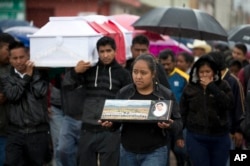Representatives of victims of a deadly clash between Mexican police and a teachers union last summer have escalated their calls for justice, briefly seizing a tollbooth on a Mexican highway, demanding a meeting with Mexico’s top law enforcement official and seeking help from the U.S.-based Organization of American States.
Last week’s moves stem from a June 19 conflict in the southern Mexican state of Oaxaca. Eight people were killed and 100 others wounded when members of the National Coordinator of Education Workers (CNTE) blocked state roads to protest mandatory teacher evaluations – part of a package of education reforms – and some union members’ arrests. Protesters at one site threw Molotov cocktails and rocks, and, as the Associated Press reported witnessing, at least one riot police officer responded with gunfire.
Since then, "we haven’t seen any significant progress" on an investigation, Ambrosio Hernández Santiago said Thursday, according to El Informador, an independent news organization in Guadalajara Jalisco. The teacher, union member and president of the Committee of Victims of Asunción Nochixtlán – named for the community where the confrontation occurred – also was quoted as saying there had been "no significant advances such as medical care" for people injured during the fracas.
Hernández offered that as explanation for the committee taking control of a tollbooth on the Oaxaca-Cuacnopalan highway for hours Thursday. He said members would "intensify our demonstrations" until they could meet with Mexico’s attorney general, Miguel Angel Osorio Chong, and get an assurance of justice. He expressed dissatisfaction with several meetings with lower-level authorities.
Trading blame
Government and union officials have traded accusations about the June incident, according to the AP. A Oaxaca state prosecutor said the dead were all civilians but not teachers; a federal police chief said the protest involved "radical groups."
The teachers union disagreed with that label, blaming the violence on police infiltrators and saying that 20 people had gone missing. More broadly, federal prosecutors contend union leaders have run an illegal network to finance protests and profit personally. Mexican unions often control teacher hiring and firing.
Last week’s tollbooth takeover follows what Hernández and others allege have been efforts to intimidate the June 19 victims and their supporters.
On March 6, the committee issued a statement asserting that the previous night, Hernández and another union member had been ambushed and shot at by unknown assailants while driving on a state road.
The committee accused "the state" of direct responsibility for "attempted murder" and also claimed that, in separate incidents, police in civilian clothing had "harassed and persecuted" June 19 victims and supporters. It called for an investigation, punishment for those responsible, and "freedom and security for our [committee] colleagues and relatives of the victims."
Official promises accountability
An official with the Mexican attorney general’s office, speaking about a related matter last week at a Washington meeting of the OAS’ Inter-American Commission on Human Rights, said his office was working on legislation "to break the chains of impunity."
Robert Campa, undersecretary for human rights, said the measure would hold culprits accountable for forced disappearances. He was discussing the 2014 case of 43 students from the Ayotzinapa Rural Teachers College who went missing in Guerrero state, Oaxaca’s western neighbor. An independent group of investigators last spring accused Mexico’s government of blocking its probe.
Oaxaca’s elected ombudsman for human rights, Arturo Peimbert Calvo, also addressed the commission in Washington. He complained that "a series of attacks, persecutions and harassment … have forced us to seek protective measures in the United States."
In an interview Tuesday with VOA, Peimbert said that, unlike with the Ayotzinapa students, in the teachers union case the "aggression of the police forces against civil society has been fully documented." He also said that, though more than 6,000 pages of testimony and 180 hours of video evidence had been collected, he worried that authorities wanted to keep the case out of the spotlight.
Peimbert made the trip to Washington "to create alliances that allow us to make the subject visible and give voice to those who have no voice and who are victims of this serious aggression," he said, adding it was "very dangerous for victims in Oaxaca."
Concerns about violence
On Friday, the human rights advocacy group Washington Office on Latin America expressed concern about increased violence in Mexico directed at human rights advocates and journalists.
In a statement, it decried attacks against Hernández and several others. It urged Mexican authorities to "implement immediate action to avoid attacks," to "recognize the important mission of journalists and defenders of human rights in Mexico and to assure that these cases don’t end in impunity."
Journalists covering the conflict in Oaxaca state have been harassed and threatened, according to the Committee to Protect Journalists (CPJ).
In an unrelated incident, Mexican reporter Miroslava Breach was shot dead outside her garage Thursday in the northern state of Chihuahua. A reporter for La Jornada, she was the third journalist to be killed in Mexico this month.








